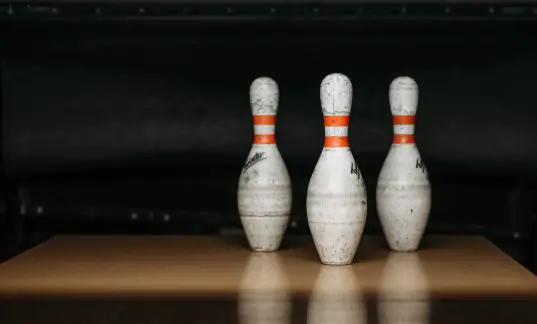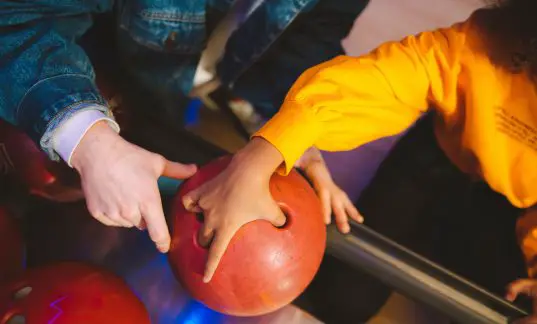You’ve bought yourself a brand-new bowling ball for your league bowling nights. You’ve got hundreds of bowling games under your belt and know the difference between the American Bowling Congress and the World Tenpin Bowling Association.
You’re a bowling aficionado. You even may have had plastic bowling pins set out as a kid!
For all of your bowling knowledge, there’s always plenty more to learn. For one, do you know how bowling pins are made and what they’re made of?
You might think you do or you might not have a clue. And that’s why we’re here to help with a deep dive into all things bowling pins! From older pins made of hard maple wood to newer models, we’ve got the skinny on the entire pin oeuvre!
What’s a bowling pin made of?
From the stone pins of ancient times to the pins of the 19th and early 20th Centuries made of a single block of maple wood, bowling pins have evolved just as frenetically as the game has! We’ve come a long way from the solid wood pins made of single maple wood pieces — pins that would often crack and break with alarming frequency.
The manufacturing process has changed considerably for modern bowling pins. Ten pins aren’t simply ten blocks of maple wood anymore. Every pin is a complex mixture of materials calibrated perfectly for today’s bowling world.
What is the core material of a modern bowling pin made of?
In the past, other core materials such as polypropylene fiberglass foam and particle lumber have been used to create bowling pins. Now, the sport’s governing bodies require all standard bowling pins to feature multi-piece cores of unused maple wood. All pieces of maple must pass rigorous testing procedures to ensure they are strong enough for regulation play.
Old bowling pins made of single blocks of maple wood were much more prone to cracking and chipping. Breaks happen with new multi-piece pins, but they are much less frequent.
What is the coating of a standard bowling pin made of?
A plastic-coated pin just won’t do when faced with the rigors of modern bowling balls and pin-setters. Pin design must include a durable coating that will protect the multi-piece maple wood core during extended usage.
That’s why nylon and DuPont’s Surlyn are used to coat modern bowling pins. Previously, ethylcellulose was applied to pins with a seven-layer process to protect the cores of pins. Now, either nylon or Surlyn is the way to go. Nylon costs less to use and is easier to apply. Surlyn is much tougher to crack but costs more.
What is the process for making bowling pins?
- When the manufacturing process begins, three pieces of maple wood are aligned in a jig and glued together.
- The edge of the formed block is shaped with a planer before the pin is weighed. If the coating thickness is off or denser wood has increased the pin’s weight past specifications, it will need to be adjusted.
- After the pin is drilled to adjust its weight, a center hole is drilled into the base of the billet (the square, beginning stages of a bowling pin’s core.)
- Every single pin is placed on a lathe after the center hole is drilled. A blade with the profile of a regulation pin then cuts it into shape.
- The coating process begins. The coating material is injection-molded onto the pin using a two-piece metal mold. Each piece of the mold coats half of a pin.
- After the coating is injected into bowling pins through small pre-placed holes called gates, water is inserted through the same tubes to cool the pin down.
- The pin is sanded down with steel wool or a sander. Everything is smoothed out before the pin is marked with any coloration or brand logos.
- After the bottom of the pin is trimmed flat for lane placement, a hard plastic ring is affixed to a notch on the bottom of the pin called a skirt. This gives the base of the pin the required dimensions for regulation play and also protects the skirt from damage.
How do modern bowling pins differ from the wooden bowling pins of years past?
As stated before, pins of the late 19th Century and early 20th Century were a bit different. Whether playing nine pins or a ten-pin bowling game, solid pins made of hard maple wood were used. There were no multi-bladed automatic saws or hard plastic sheath coatings to be had. Pins cracked frequently and their usage life was far shorter than nowadays.
And then, in 1954, Vulcan Manufacturing changed the bowling pin production process with the introduction of a two-piece bowling pin. With more edge grain for protection and a more malleable design, these pins were much more durable than those before. While bowling scores still depend on you, the world bowling community has Vulcan to thank for creating a pin that can handle the speeds and impacts of the modern game!
Are bowling pins weighted?
When bowling pins are made, they must ultimately weigh between 3 pounds, 6 ounces and 3 pounds, 10 ounces to be used in regulation play. No added metal or wooden weights are added to the pin. However, the pin is drilled and shaped to ensure that it hits the allotted weight target.
How long does a bowling pin last?
Even the most well-made bowling pins will eventually break or outlive their usefulness. According to data provided by bowling alleys around the United States, pins are usually replaced every 12 to 24 months. It all depends on how often they’re used over that span.
Frequently Asked Questions
Are old bowling pins made of hard rock maple wood still used?
Unless you’re playing at a throwback bowling alley, it’s unlikely that you’ll be playing with single-block bowling pins. Some operators pride themselves on a classic bowling center experience, though. So, it’s not out of the realm of possibility!
Are ten-pin bowling pins made of different materials than duckpin bowling pins and pins for other games?
Because the pins are shaped differently in different bowling games, each pin for each different game has different requirements. For example, bowling pins for arcade games are made of plastic material. It just depends on the game and if there are any regulations in place to monitor the production of the pins.
Is an automatic pin setter used at most bowling alleys?
In the past, attendants known as pin boys were paid to reset pins after every shot. Nowadays, the vast majority of bowling alleys around the world use automatic pin-setters for the job!
Do organizations like the Women’s International Bowling Congress and United States Bowling Congress have bowling pin specifications and requirements for bowling balls?
Yes! All regulation bowling pins should be at least three pounds, six ounces (and no more than three pounds, ten ounces), and meet required standards for height, width, and circumference. As for bowling balls, they must meet similar requirements for circumference and cannot exceed sixteen pounds to be considered for sponsored league or tournament play.
How many bowling pins are there in a normal bowling lane? A normal bowling alley or bowling center?
Each pin-setter is usually stocked with 20 pins — ten for the ongoing frame and ten for the next. If a bowling alley has 40 lanes, then there are likely 800 pins in use plus any extras they have stocked in the backroom.
Closing Thoughts
Now that’s you’ve got enough bowling pin knowledge to be one of the pin boys, you can head to your local bowling center with plenty of trivia to share! The more you know about the equipment used in the bowling game, the better chances you have of succeeding at one of the trickiest sports in the world. It never hurts to know more. And it never hurts to know your enemies before you blast bowling pins everywhere with a well-placed pocket shot.

